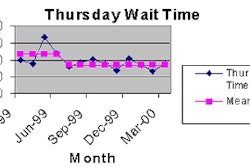LAS VEGAS – Documenting the services a radiology facility provides to its patients is not just a matter of complying with the rules of various state and U.S. federal healthcare agencies. It also makes good business sense, potentially saving an institution millions of dollars, according to a coding expert.
Cindy Parman, managing partner of Dallas, GA-based Coding Strategies, offered her insight on service documentation and radiology coding risks in a presentation at the American Healthcare Radiology Administrators' annual conference yesterday.
"The biggest mistake I see made by radiology practices is incomplete documentation of services. Remember, in today’s ‘delay and deny’ claims environment, if it’s not written down, it didn’t happen," counseled Parman.
Complete documentation
A radiology center should maintain a file that contains a copy of the referring physician’s order. This file should also contain notes about the substance of any conversation, including date and time, between the referring physician and any staff member. If there are discrepancies between claims of what was ordered and what was provided, these notes may prove to be invaluable.
In one example, "a referring physician, who ignored a radiologist’s advice to order a CT for an abdominal scan, later accused the radiologist of malpractice. The patient died and the referring physician claimed the radiologist had not provided him information of other test possibilities. Unfortunately, the radiologist had not kept notes of his phone conversations with the referring physician. The imaging center settled out of court," said Parman.
The file also needs to contain a copy of the report generated from the referring physician’s order. Parman stressed that a report must be completed for each radiological examination.
"Codes are selected to accurately describe the documented services; thus, the radiology report is going to be a document that should be the beginning and end of an audit trail," she noted.
Parman told the audience that multiple radiological exams on the same patient might be listed on the same report. But in order to get reimbursement for the exams, each item should have separate paragraphs, or otherwise be separately billable.
Correct coding
The documentation of services file also needs to include the billing codes generated from the radiology report. Each code should directly relate to an item in the report. This leaves little room for a payor to deny a claim for radiology services rendered.
Parman observed that diagnosis codes sometimes could not be filled completely, due to an incomplete or unknown diagnosis. Therefore, a three-digit diagnosis code may not be able to have the fourth and fifth digit level of specificity needed for reimbursement.
"Although the specific diagnosis may not be known at the time of service, ICD-9 codes must still include the fourth or fifth digits," she advised. A facility may thus choose to use the ‘unspecified’ or ‘other’ diagnosis categories in these instances
If there is some doubt as to the correct code used for reimbursement for the exam, note the choice made and the reason for the decision in the documentation of service file. This kind of detailed reporting ensures that when an audit occurs, the facility will be able to show a prudent and thorough consideration of its billing practices on a case-by-case basis.
"If you aren’t willing to write complete documentation of each service your facility provides, then you ... may be writing lots of checks," observed Parman. "An Office of Inspector General audit is an expensive way to learn to keep good records."
By Jonathan S. BatchelorAuntMinnie.com staff writer
July 31, 2001
Related Reading
What every radiologist should know about medical billing, July 27, 2001
Revenue review revitalizes reimbursement, June 19, 2001
OIG audits are scary but survivable, September 22, 2000
Copyright © 2001 AuntMinnie.com



















